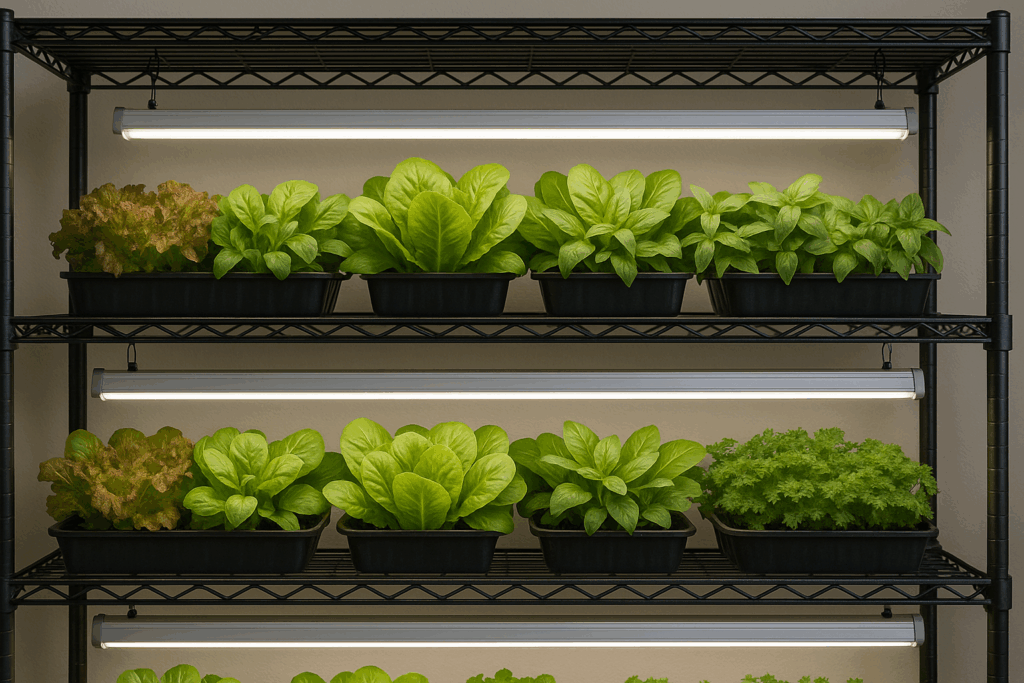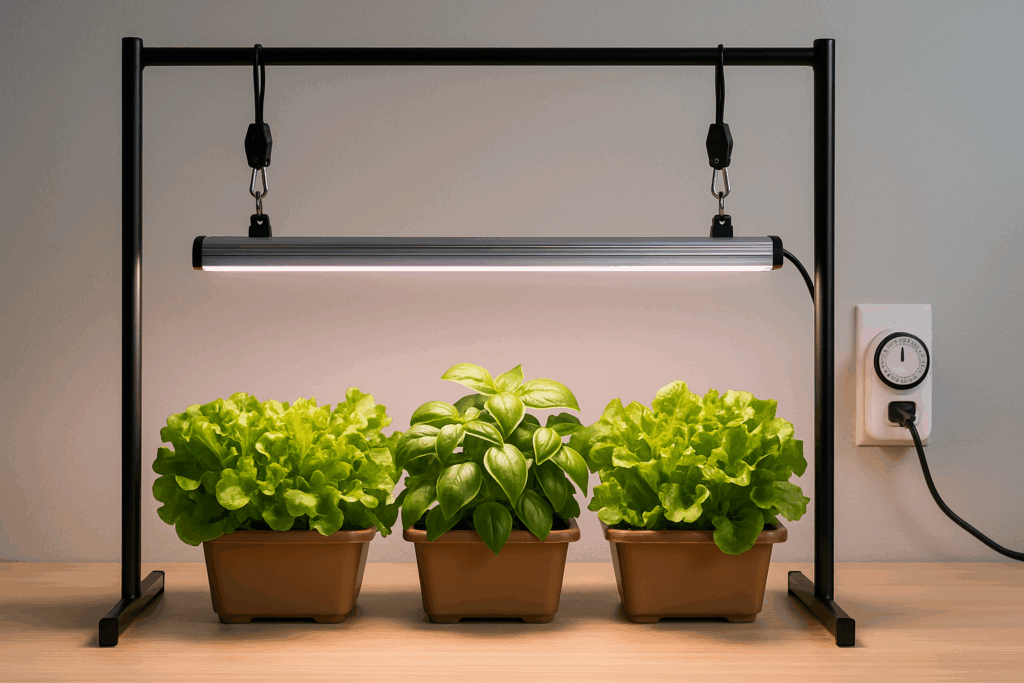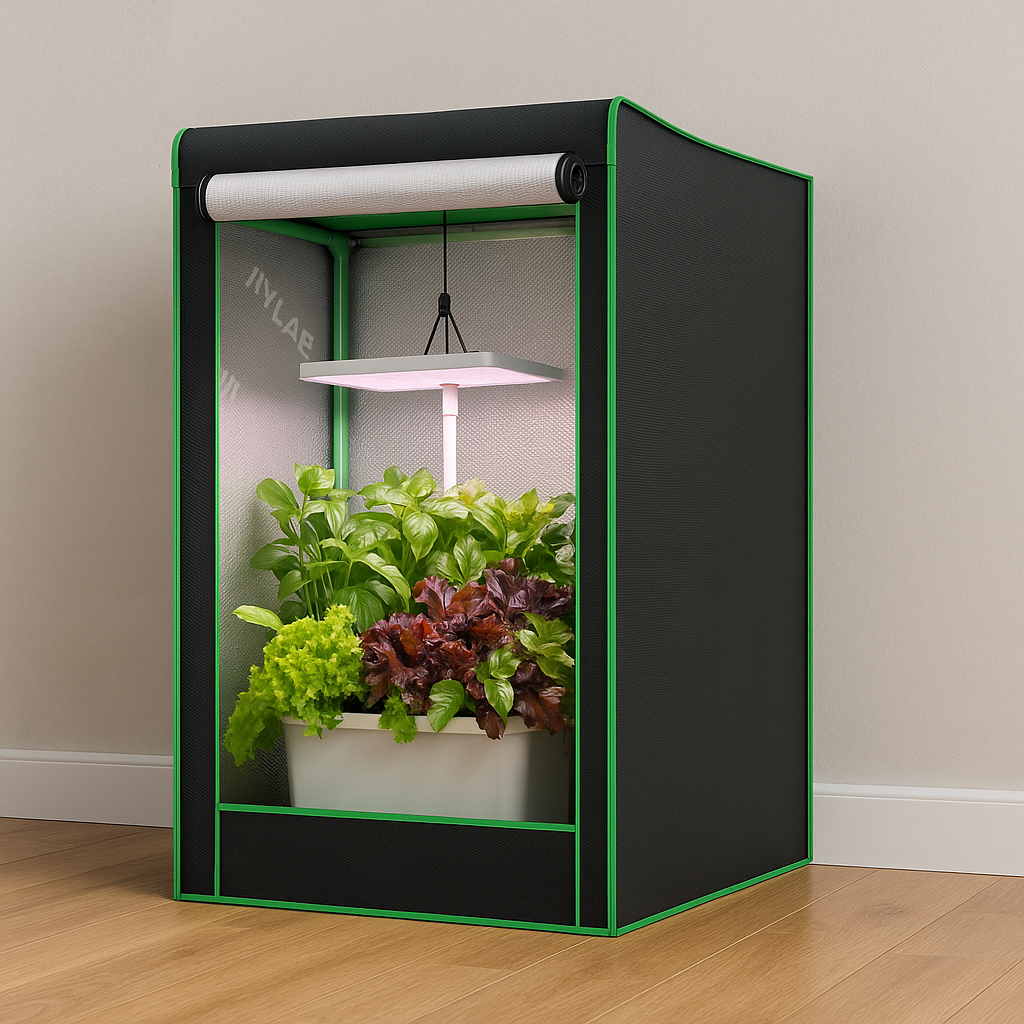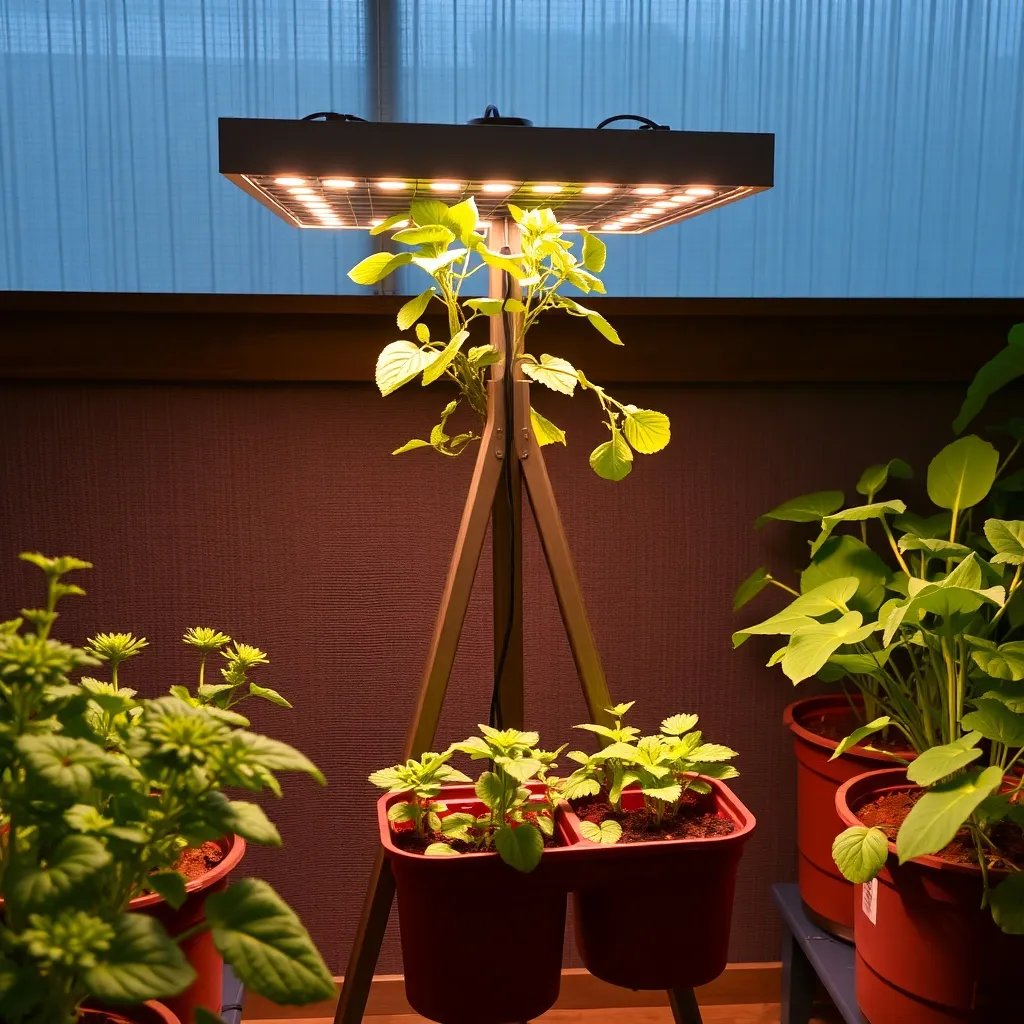
If you’re wondering how to set up grow lights indoors, this beginner-friendly UK guide walks you through everything step-by-step. We’ll look at how to choose the right location, how high to hang your light, and how to set timers so your plants get the perfect amount of light each day. With the right setup, you can grow herbs, salads, chillies and vegetables all year round, even through the darker winter months.
If you need a broader overview of lighting types, efficiency and running costs, take a look at our Grow Lights UK – Complete Resource Hub.
🧰 What You’ll Need (Simple Checklist)
You don’t need everything here, but these basics make indoor grow light setups smooth:
- A grow light (LED panel, strip, or bulb)
- Something to hang or stand it on (tripod, rope ratchets, shelving unit)
- A plug-in timer (mechanical or smart)
- Tape measure
- Optional: reflective surfaces, small grow tent, light meter app
📍 Step 1: Choose the Right Spot
A good location makes indoor growing far easier. Look for:
- Stable temperature
- No strong draughts
- A nearby plug socket
- Some airflow (cracked window or small fan)
Avoid radiators, damp sheds, or bright hot windows that cause glare.
📏 Step 2: Hang Your Grow Lights at the Right Height
General height guidelines:
- LEDs: 12–24 inches (30–60 cm) above plants
- Fluorescent/T5: 6–12 inches
Use ratchet hangers for easy adjustments.
Too high: leggy, weak plants
Too close: scorched or bleached leaves
Hand test: if it feels too warm on your hand, it’s too warm for seedlings.

Step 3: Add a Timer (Set and Forget)
⏱️ Step 3: Add a Timer (Set & Forget)
Timers make your grow light setup consistent and efficient.
Recommended light cycles:
- Seedlings: 16–18 hours
- Leafy greens/herbs: 14–16 hours
- Fruiting plants: 12 on / 12 off once flowering
A mechanical timer is fine, but smart plugs or smart power strips work too
📈 Step 4: Adjust Your Lights as Plants Grow
Lights must move as plants grow.
- Raise the light gradually
- Rotate pots/trays for even light
- Watch for plant signals
Pale/leggy: increase light or lower the fixture
Crispy edges: raise the light or reduce intensity
You can use Photone (iOS) or Lux Light Meter (Android) to estimate light levels.

🔁 Step 5: Add Reflective Surfaces (Optional)
Reflective materials help bounce light back onto your plants:
- Foil-covered cardboard
- White walls
- Small grow tent
- Mylar sheets
These improve efficiency, especially in winter.
❌ Common Mistakes to Avoid
- Leaving lights on 24/7
- Hanging lights too high
- Not adjusting height
- No airflow (risk of mould/fungus gnats)
- Overwatering under strong lights
📚 Bonus Tip: Stackable Indoor Grow Shelving
If space is tight, use a vertical shelving system:
- Metal shelving unit (e.g., IKEA Hyllis)
- LED strips such as Barrina T5 under each shelf
Great for herbs, lettuce, and microgreens.
🌿 Conclusion
With your grow lights now set up correctly, you’re ready to enjoy fresh herbs and vegetables any time of year — even during winter. A simple indoor setup can make a surprising difference to your daily harvest and your self-sufficiency goals.
If you’d like more neutral, expert-led information, the RHS website is an excellent resource. As the UK’s largest gardening charity, they offer trusted advice on a huge range of growing topics.
📎 Related Articles
• Best Cheap Grow Lights UK
Our full comparison of the most affordable bulbs, bars, clip-ons and panels that actually work.
• Top 10 LED Grow Lights UK
Our main comparison of the best LED grow lights across all budgets — from entry-level to high-performance.
• Best Indoor Grow Lights UK for Beginners
A clear starter-friendly guide to choosing simple plug-in lights for herbs, seedlings and houseplants.
• Best Grow Lights for Every Tent Size
Find the right light output, coverage and wattage for 40×40, 60×60, 80×80 and 120×120 cm grow tents.
• Top Grow Light Stand Systems
Freestanding systems for shelves, seed trays and indoor propagation.
• Grow Light Distance Chart UK
A practical chart showing recommended hanging heights for bulbs, bars and LED panels.
• How to Set Up Grow Lights
Step-by-step guidance on positioning, timers, reflective surfaces and optimising plant growth.
🏡 Explore More HomeGrower Hubs
Dive deeper into our core growing and self-sufficiency guides:
- Indoor Growing UK
Everything you need to grow herbs, vegetables and microgreens indoors all year round. - Grow Lights UK
Compare LED, fluorescent and full-spectrum grow lights for home growers. - Grow Tents UK
Reviews, setup guides and ideal tent sizes for beginners and experienced growers. - Outdoor Growing UK
Advice on raised beds, irrigation, composting and year-round food production. - Greenhouses & Polytunnels UK
Expert guidance for choosing, installing and using protected growing structures. - Garden Sheds UK
Buying guides, comparisons and storage advice for every UK garden. - Garden Tools & Equipment UK
Essential tools, equipment reviews and buying guides for efficient gardening. - Food Preservation UK
Learn dehydration, fermentation, freezing and long-term storage of home-grown produce. - Self-Sufficiency UK
Guides to home solar, emergency power, rainwater collection, off-grid watering and low-energy systems for more resilient living.
Or return to the HomeGrower homepage to browse all our latest guides and reviews.
How do I set up grow lights indoors for beginners?
Start by choosing a stable location with a nearby plug socket. Place the lights 12–24 inches above plants (LED) or 6–12 inches (fluorescent), and use a timer for consistent light cycles.
How many hours a day should grow lights be on indoors?
Seedlings need 16–18 hours of light. Leafy greens and herbs grow well with 14–16 hours, while fruiting plants like chillies or tomatoes need around 12 hours once they flower.
Can I grow vegetables indoors with LED grow lights in the UK?
Yes. LED grow lights make it possible to grow herbs, lettuce, leafy greens, and even chillies or tomatoes indoors year-round in the UK.
Do I need a timer for indoor grow lights?
A timer is highly recommended. It ensures plants get consistent light cycles — for example, 16–18 hours for seedlings and 12–16 hours for mature plants.
What is the easiest way to set up grow lights indoors?
The easiest way to set up grow lights is to place them above your plants on a shelf or stand, keep them 12–24 inches away (for LEDs), and use a plug-in timer for consistent light cycles.
Do I need special equipment to set up grow lights at home?
No — you only need a light, something to hang or support it, and a timer. Many beginners simply use a shelf unit when learning how to set up grow lights for the first time.
How do I know if my grow light setup is strong enough?
A simple way to check is to look at your plants. If they look leggy or lean toward the light, your setup needs adjusting. This is very common when people first learn how to set up grow lights.
